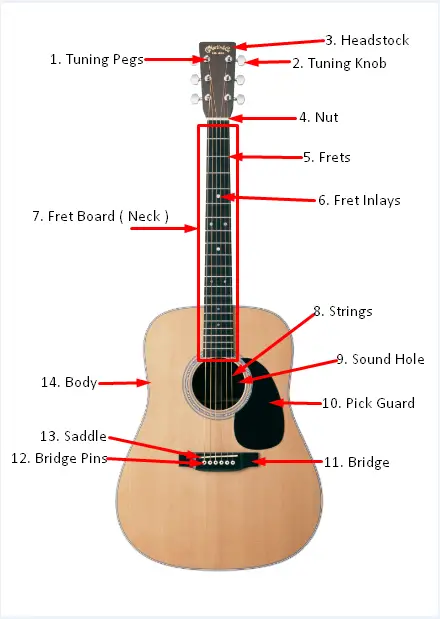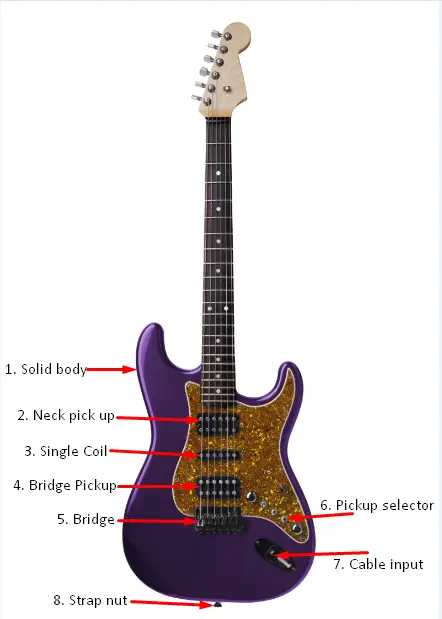In this lesson, I will help you in getting familiar with the parts of an acoustic and electric guitar. As a newbie, it is very important to know the parts of a guitar. There are several benefits to it. The 2 benefits are:-
1. It will help you in communicating with other fellow guitarists and musicians easily.
2. It will help you to repair or do minor adjustments to your guitar if the problem arises.
What are the parts of an Acoustic Guitar
First, let’s take a look at the parts of an acoustic guitar. An acoustic guitar is very much different from an electric. You can carry and play an acoustic guitar anywhere without the need of any extra elements like an amplifier. In the case of electric guitar, you need those fancy amplifiers and cables to make those heavy sounds like a rockstar.
Anyways let’s take a look on the parts.

As you can see there are 14 main parts of an acoustic guitar, now let’s see all these parts in detail and why each of these parts is important.
Parts of an acoustic guitar and what they do
1. Tuning pegs – Tuning pegs are small iron rods with a small hole in the center. It is fitted on the headstock of the guitar and acts as a hook to connect the strings from the bridge of the guitar.
2. Tuning Knobs – Tuning knobs acts as the key to tune the guitar by rotating it clock and anti-clockwise. Some high-end guitars also have automatic tuning knobs.
3. Head stock – The head stock is the part where the tuning knobs and tuning pegs are connected to each other. There are guitars in the market that doesn’t have any head stock but they are very high priced.
4. Nut – The nut is a small and straight solid bar that rests over and between the head stock and the guitar neck. The main use of it is to keep all the strings in the same position.
5. Frets – Guitar frets are the division of the fretboard. A small size guitar has less number of frets compared to a standard size guitar. Each fret produces a different note when the strings are plucked.
6. Fret Inlays – Fret inlays are marks or dots or design present generally on the 3rd, 5th, 7th, 9th, 12th, 15th, 17th fret of a standard guitar. These marks and dots helps in recognizing the fret number easily. There are also custom guitars where there are no inlays or any dots at all.
7. Fret Board ( neck ) – Fretboard is also called the neck of the guitar. It is divided into frets that I have mentioned in the fret section. Fretboards, made up off different wood quality produces different sound. The most common wood used for making fretboard are rose wood, maple and mahogany.
8. Strings – A standard guitar has basically 6 strings. It is named as e, b, g, d, a, e from thinnest to thickest. There are also guitars that have 7, 8, and 12 strings.
9. Sound Hole – It is the main source of sound in an acoustic guitar that is produced when the strings are plucked or strummed.
10. Pick Guard – A pick guard prevent scratches that is caused by the pick when it is used to strum or plucking (picking).
11. Bridge – The bridge of an acoustic guitar is fitted on the body of the guitar. It acts as a device to hold the strings as they travel through the neck and connects to the headstock.
12. Saddle Pins – A saddle is a solid piece of material that rests over the bridge via which the string passes through the neck and connects to the tuning pegs. It looks similar to the nut of the guitar.
13. Bridge Pins – Bridge pins are used to fit the strings firmly over the bridge of an acoustic guitar.
14. Body – An acoustic guitar has a hollow body, unlike typical electric guitars. It is the main source of sound in an acoustic guitar and it comes in different shapes and sizes from small to jumbo. Each one produces a different sound.
Parts of an Electric Guitar and what they do
Most of the parts of the electric guitar are the same as the acoustic guitar. So, I will be showing you the parts that are exclusive in an electric guitar. Let’s take a look.

1 . Solid body – Electric guitar has a solid body unlike an acoustic guitar.
2. Neck pick up – Pick up is a device exclusively made for electric guitar. It basically converts the string vibration to an electric signal and then produces sound through an amplifier. We call it neck pick up because it is placed closer to the neck of the guitar. This pick up is widely used while soloing.
3. Single coil – It is a type of pick up that used to produce a brighter sound. Best when using a clean tone.
4. Bridge pickup – Bridge pickups are used to produce a heavy and hotter sound. It is widely used in metal and rock music when playing rhythm guitar.
5. Bridge – Similar to an acoustic guitar a bridge is used to hold the strings while it travel through the fretboard and connect to the head stock.
5. Pick up selector – As the name suggests, it is basically used to select the pick ups.
6. Cable input – It is used to connect the guitar to an amplifier via a cable.
7. Strap nuts – It is used to hold the straps firmly.
Wrap up
This is the basic details of the parts of an acoustic and electric guitar. As you go deep into playing guitar you will eventually understand it clearly.




